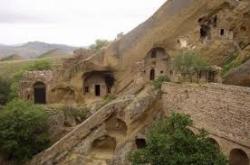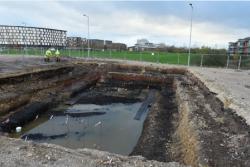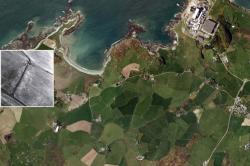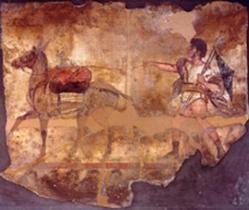INSTITUT SUPERIEUR D'ANTHROPOLOGIE
INSTITUTE OF ANTHROPOLOGY
ONLINE COURSES / COURS A DISTANCE
WINTER TERM : JANUARY 2016
REGISTER NOW
AZERBAIDJAN –  Keshikchidagh - "Archaeological research we’ve conducted in the area where the Keshikchidagh monastery complex (David Gareji) is situated shows that the caves located there were actually temples of fire worshipers. After the Caucasian Albania’s conversion to Christianity, churches were built in those same impassable places during the reign of Albanian King Vache II, the department head at the ANAS Institute of Archeology and Ethnography and doctor of historical sciences, Arif Mammadov, who is leading archeological research at the Keshikchidagh monastery complex, told APA. He said Georgian elements in the Keshikchidagh monastery complex began to emerge in 1836. “In 705, the Arab Caliphate ordered the closure of Albanian churches. But they still were open until the Synod in Petersburg decided to close them in 1836. At the time, there was little interest in churches because Islam had been deeply established in Azerbaijan. So there began to manifest Georgian elements in churches located in Georgia. There are descriptions inside some of the 72 caves in the area of the Keshikchidagh monastery complex. The castle-churches up there have nothing to do with Georgians. A photograph shot by Georgian historian Muskhelishvili in 1948 shows quite a different view of today’s Keshikchidagh monastery complex. Temples in Georgian territory have gone through extensive restoration and even those located in Azerbaijani territory have been restored by Georgians. It seems they have done some falsification too during the restoration,” said Arif Mammadov.The department head added that today the monastery complex is located at the Azerbaijan-Georgia border but in fact, considering the Caucasian Albania used to cover far larger areas than modern-day Azerbaijani territory, those caves should have been located at the heart of the Caucasian Albania, far from the modern border. “Some of those caves in the same form are located in the Republic of Georgia, at a distance of 10-12km from the border. I and Imash Hajiyev study the descriptions in those temples. Archeological research in that area discovered that at the foot of the area where the monastery complex is located there are barrows dating back to the Late Bronze and Early Iron ages,” said the historian. He also noted that materials found during excavation prove that early human settlements in that area may have begun at least the late second millennium B.C. and the first millennium B.C. “Human settlements emerged there during the Iron Age and lasted until the late Middle Ages,” he said. The historian stressed that there is a need for new archeological work at the Keshikchidagh monastery complex.
Keshikchidagh - "Archaeological research we’ve conducted in the area where the Keshikchidagh monastery complex (David Gareji) is situated shows that the caves located there were actually temples of fire worshipers. After the Caucasian Albania’s conversion to Christianity, churches were built in those same impassable places during the reign of Albanian King Vache II, the department head at the ANAS Institute of Archeology and Ethnography and doctor of historical sciences, Arif Mammadov, who is leading archeological research at the Keshikchidagh monastery complex, told APA. He said Georgian elements in the Keshikchidagh monastery complex began to emerge in 1836. “In 705, the Arab Caliphate ordered the closure of Albanian churches. But they still were open until the Synod in Petersburg decided to close them in 1836. At the time, there was little interest in churches because Islam had been deeply established in Azerbaijan. So there began to manifest Georgian elements in churches located in Georgia. There are descriptions inside some of the 72 caves in the area of the Keshikchidagh monastery complex. The castle-churches up there have nothing to do with Georgians. A photograph shot by Georgian historian Muskhelishvili in 1948 shows quite a different view of today’s Keshikchidagh monastery complex. Temples in Georgian territory have gone through extensive restoration and even those located in Azerbaijani territory have been restored by Georgians. It seems they have done some falsification too during the restoration,” said Arif Mammadov.The department head added that today the monastery complex is located at the Azerbaijan-Georgia border but in fact, considering the Caucasian Albania used to cover far larger areas than modern-day Azerbaijani territory, those caves should have been located at the heart of the Caucasian Albania, far from the modern border. “Some of those caves in the same form are located in the Republic of Georgia, at a distance of 10-12km from the border. I and Imash Hajiyev study the descriptions in those temples. Archeological research in that area discovered that at the foot of the area where the monastery complex is located there are barrows dating back to the Late Bronze and Early Iron ages,” said the historian. He also noted that materials found during excavation prove that early human settlements in that area may have begun at least the late second millennium B.C. and the first millennium B.C. “Human settlements emerged there during the Iron Age and lasted until the late Middle Ages,” he said. The historian stressed that there is a need for new archeological work at the Keshikchidagh monastery complex.
http://en.apa.az/xeber_institute_of_archaeology_and_ethnography_235496.html
ROYAUME UNI – x Lincoln – Archaeologists have discovered stone and flint tools from the people who hunted deer and foraged for berries up to 11,000 years ago at what we now know as the University of Lincoln campus. The team from Allen Archaeology have excavated tonnes of mud from 3 metres below the ground, and sifting the earth has revealed knives probably used for hunting and cutting meat and preparing plants for eating. Gavin Glover, project manager, said: "There's a known Mesolithic flint scatter close to this particular site from somewhere between 9,000BC and 5,000BC and we have found a continuation of that. "The finds are stone and flint tools, which tend to be small cutting blades for domestic use including hunting, butchering animals and preparing plants. "The site would have been a sandbar at the edge of the water of what would have been the forerunner of the Brayford Pool. "This was a time before farming when people would have lived in small groups moving through the landscape hunting deer and foraging for plants and berries."
x Lincoln – Archaeologists have discovered stone and flint tools from the people who hunted deer and foraged for berries up to 11,000 years ago at what we now know as the University of Lincoln campus. The team from Allen Archaeology have excavated tonnes of mud from 3 metres below the ground, and sifting the earth has revealed knives probably used for hunting and cutting meat and preparing plants for eating. Gavin Glover, project manager, said: "There's a known Mesolithic flint scatter close to this particular site from somewhere between 9,000BC and 5,000BC and we have found a continuation of that. "The finds are stone and flint tools, which tend to be small cutting blades for domestic use including hunting, butchering animals and preparing plants. "The site would have been a sandbar at the edge of the water of what would have been the forerunner of the Brayford Pool. "This was a time before farming when people would have lived in small groups moving through the landscape hunting deer and foraging for plants and berries."
http://www.lincolnshireecho.co.uk/secrets-huge-hole-University-Lincoln-revealed/story-28241984-detail/story.html#1
ROYAUME UNI –  Anglesey - Archaeologists from Bangor have been making ground-breaking discoveries about the Romans in Wales using specialist electronic equipment. The latest discovery by Gwynedd Archaeological Trust is a Roman fortlet at Cemlyn on north Anglesey, which they were alerted to after local aerial photographer and historian Mary Aris spotted a faint circular mark in crops on a low hill overlooking the Anglesey coastline. David Hopewell, of the trust, explained that high-tech geophysical survey detects minute changes in the magnetic properties of the soil, allowing archaeologists to build up a map of buried remains without even putting a spade into the ground. Mr. Hopewell carried out the survey and reported that the results were unusually clear showing the unmistakable outline of a Roman fortlet - a smaller version of a Roman fort often found at significant points on Roman roads or at lookout points - and faint traces of rectangular buildings that are probably barracks, thought to date from the end of the first century AD. The discovery is surrounded by a circular ditch, something not seen anywhere else in Wales though similar fortlets have been found on the north coast of Devon where it is thought that signal beacons were lit inside the circular enclosure. More details of the fortlet and the work of Gwynedd Archaeological Trust can be found at their website www.heneb.co.uk
Anglesey - Archaeologists from Bangor have been making ground-breaking discoveries about the Romans in Wales using specialist electronic equipment. The latest discovery by Gwynedd Archaeological Trust is a Roman fortlet at Cemlyn on north Anglesey, which they were alerted to after local aerial photographer and historian Mary Aris spotted a faint circular mark in crops on a low hill overlooking the Anglesey coastline. David Hopewell, of the trust, explained that high-tech geophysical survey detects minute changes in the magnetic properties of the soil, allowing archaeologists to build up a map of buried remains without even putting a spade into the ground. Mr. Hopewell carried out the survey and reported that the results were unusually clear showing the unmistakable outline of a Roman fortlet - a smaller version of a Roman fort often found at significant points on Roman roads or at lookout points - and faint traces of rectangular buildings that are probably barracks, thought to date from the end of the first century AD. The discovery is surrounded by a circular ditch, something not seen anywhere else in Wales though similar fortlets have been found on the north coast of Devon where it is thought that signal beacons were lit inside the circular enclosure. More details of the fortlet and the work of Gwynedd Archaeological Trust can be found at their website www.heneb.co.uk
http://www.northwaleschronicle.co.uk/news/155425/archaeologists-discover-roman-fortlet-on-anglesey.aspx?
CHINE - Guangzhou - Archeologists in south China's Guangdong Province have found over 50 ancient tombs in a suburb of the provincial capital of Guangzhou, authorities said Thursday. The complex, discovered three months ago, is believed to have been built during the Spring and Autumn Period (770 BC - 476 BC), according to Guangzhou institute of cultural relics and archaeology. The complex covers about 2,000 square meters, and all tombs are rectangular, from 2.1 to 2.8 meters long and 1.2 to 1.4 meters wide. Zhang Qianglu, official with the institute, said, archaeologists have found plenty of ceramics and porcelain, alongside some bronze axes and arrowheads. The relics found there show that the tombs' occupants should all be civilians, probably belonging to the same clan, he added. Zhang said the well-preserved tombs are of great value to the study of ancient culture and customs in China's Pearl River Delta.
http://news.xinhuanet.com/english/2015-11/26/c_134858936.htm?
ITALIE –  Paestum - he Carabinieri art squad has found pieces of a frescoed Samnite tomb dating back to the fourth-third century BC, it emerged Thursday. The remains come from the archaeological area of Paestum near Naples.One of the plates depicts a young hero armed with a circular shield and a javelin leading a mule carrying a small dog. The details of the find were illustrated at the Historic Museum of the Carabinieri in Rome during the presentation of the exhibition 'L'Arma Custode della Memoria' (The Carabinieri Corps, Custodian of Memory). Culture Minister Dario Franceschini, the General Commander of the Carabinieri Corps Tullio Del Sette and the new director of Paestum archaeological area, Gabriel Zuchtriegel, attended. Germany's Zuchtriegel, 34, is one of 20 new directors appointed earlier this year following an international selection competition to head up Italy's major museums and archaeological areas under a shake-up of the national cultural heritage.
Paestum - he Carabinieri art squad has found pieces of a frescoed Samnite tomb dating back to the fourth-third century BC, it emerged Thursday. The remains come from the archaeological area of Paestum near Naples.One of the plates depicts a young hero armed with a circular shield and a javelin leading a mule carrying a small dog. The details of the find were illustrated at the Historic Museum of the Carabinieri in Rome during the presentation of the exhibition 'L'Arma Custode della Memoria' (The Carabinieri Corps, Custodian of Memory). Culture Minister Dario Franceschini, the General Commander of the Carabinieri Corps Tullio Del Sette and the new director of Paestum archaeological area, Gabriel Zuchtriegel, attended. Germany's Zuchtriegel, 34, is one of 20 new directors appointed earlier this year following an international selection competition to head up Italy's major museums and archaeological areas under a shake-up of the national cultural heritage.
http://www.ansa.it/english/news/2015/11/26/carabinieri-uncover-pieces-of-frescoed-paestum-tomb-3_ed8eb0bf-439d-4210-b64b-a7a651e4cfc6.html?